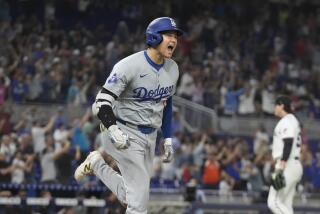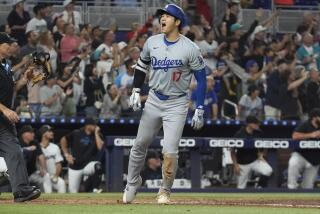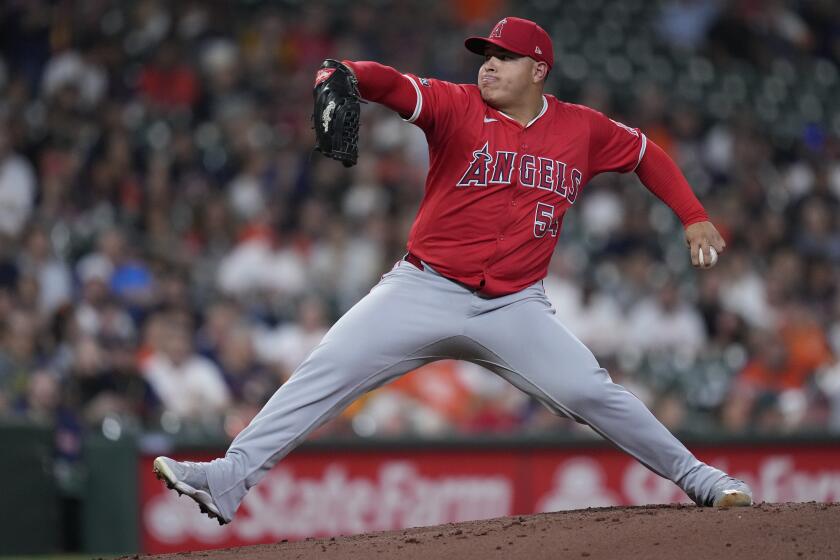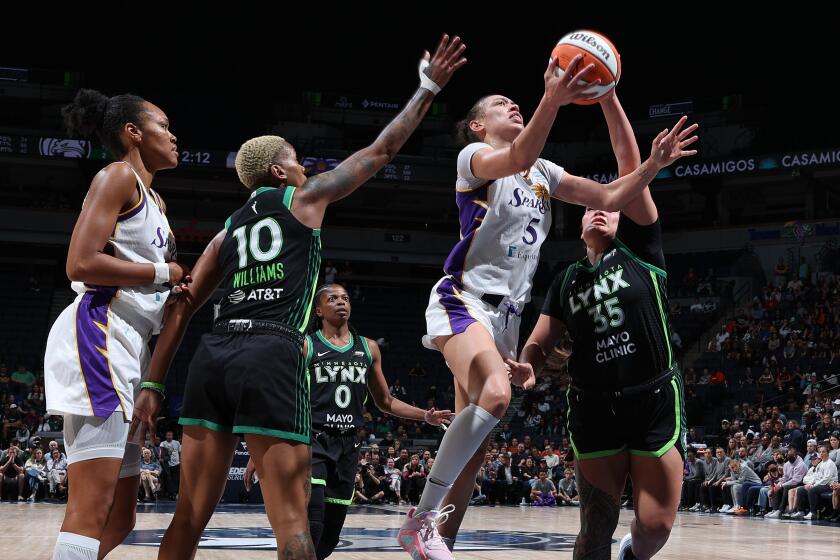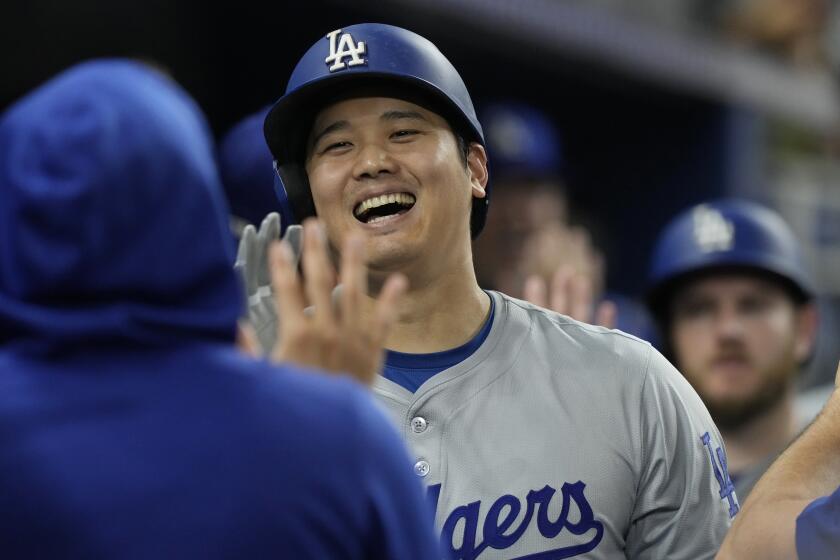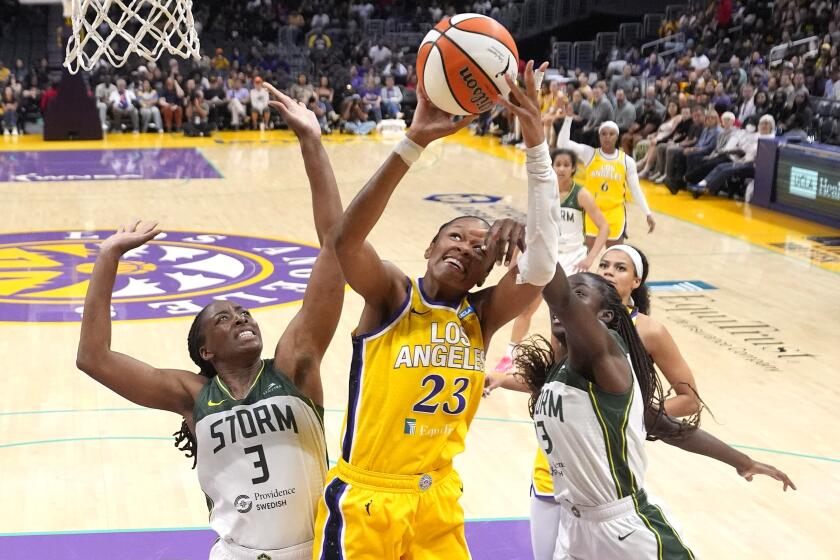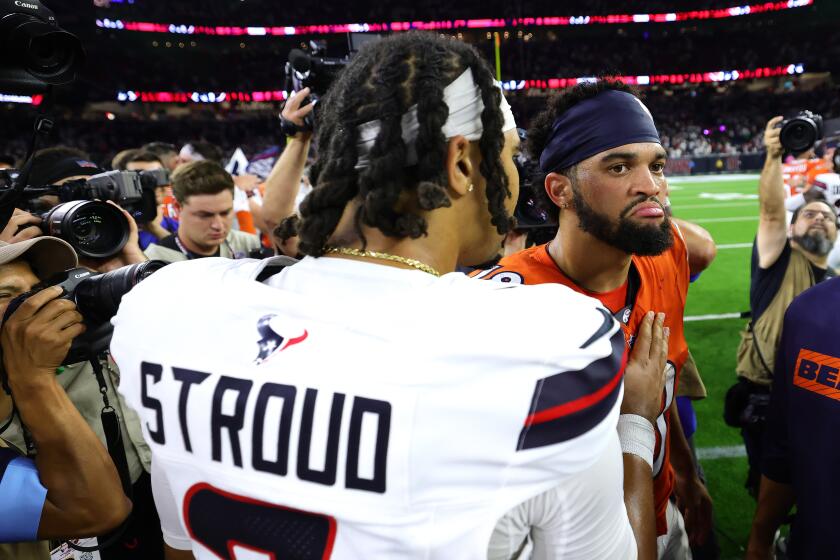King of the college cowboys
IF BEN LONDO’S game were football, he’d be as famous as Reggie Bush, the former USC running back who won last year’s Heisman Trophy as the country’s best college football player.
More famous, actually. Londo, a Cal Poly San Luis Obispo senior, has won his rugged sport’s equivalent of the Heisman for two years in a row, and is intent on winning it again this season.
And all Reggie Bush had to worry about was the occasional 250-pound human being coming hard at him.
During a recent practice session, Londo squatted and stretched, then surreptitiously kissed the St. Christopher medal dangling from his neck before lowering himself onto 1,500 pounds of seriously perturbed stallion confined in a bucking chute.
Londo was the all-around champion at the National College Rodeo Finals in 2005 and 2006, but the dun horse with the white face patch seemed unimpressed. As Londo’s 170 pounds settled into the saddle, the animal shook and lurched with seismic violence; he kicked the metal sliding door behind him so hard the blows sounded like large-caliber pistol shots.
“Everybody ready?” Londo asked two teammates who controlled the chute gate leading to Cal Poly’s rodeo arena.
The gate opened and the big saddle bronc exploded into the arena, leaping high and bucking so hard the tightly cinched saddle slipped toward his hindquarters.
“Whoa, that sucker’s wired!” yelled Cal Poly rodeo Coach Tony Branquinho from atop the chute.
A mighty kick of the animal’s rear legs and Londo was airborne, flipping headfirst over the stallion’s arched neck. Down into the dust he went. The horse, as though to underscore a point, briefly trampled Londo for his hubris, then galloped off.
A few minutes later, Londo was back at the chute, pale cowboy hat askew, white western shirt streaked with dirt, eyes aglow. “Holy cow, that was a buckin’ horse,” he said. “There’s no shame in gettin’ bucked off a horse like that.”
LONDO, an easygoing 22-year-old construction management major and dean’s list student from Milton-Freewater, Ore., could serve as the exemplar of college rodeo, which, though largely unfamiliar to urban and suburban America, has been a mainstay on agriculturally oriented campuses since the 1930s.
Nowadays, 140 junior and four-year colleges belong to the sport’s sanctioning body, the National Intercollegiate Rodeo Assn. Cal Poly’s program, of which Londo is the inspirational leader, is one of the nation’s best, “in the top five,” said Branquinho.
Cal Poly has won three national individual titles in the last two years. At the most recent nationals, last June in Casper, Wyo., Londo won his second consecutive all-around title, rodeo’s most prestigious individual honor, awarded the competitor who amasses the highest combined score in two or more events. He finished fourth in saddle bronc riding and 27th in his other event, bareback riding. The Cal Poly women’s team finished eighth overall, and the men’s team ninth.
At the 2005 nationals, Londo won his first all-around title, and then-teammate Marcey Teixeira won the women’s all-around honors.
The team’s success is particularly noteworthy because of Cal Poly’s relatively rigorous academic standards. Most of the schools in the intercollegiate association are community colleges, where entrance requirements aren’t as stringent.
Londo, who has reddish blond hair and a scattering of pale freckles, is a compact 5 feet 8. For participants in the “roughstock” events -- saddle bronc, bareback and bull riding -- excessive height can be a disadvantage because it means having a higher center of gravity and being prone to more pronounced whiplash from the bucking animal.
Like most other college rodeo participants, Londo grew up around livestock, on his parents’ cattle ranch, where he began riding at age 10. And, as with many others, rodeo is a family tradition. His father, Ned, competed both in college and professionally, even reaching the Wrangler National Finals Rodeo (WNFR), the pinnacle of professional competition.
“Rodeo’s been in my family for four generations,” Londo said. “Growing up in the country, it’s so related to the work we do every day. It’s more than a sport. It’s a heritage deal.”
*
THE day after the dun stallion bucked him off, Londo took a break between classes and sat in the temporary building that serves as the rodeo team’s offices to talk about the peculiar attractions of his sport.
“It gets my blood pumpin’ just talking about it,” he said. “Last night I was rolling over in my bed just thinking of getting on that horse again -- and riding him this time. I guess it’s the adrenalin rush that gets you, the danger, the power. Getting a good ride, nothing else makes you feel that good.”
The thrills, however, are dearly paid for -- particularly in fractured limbs and torn musculature.
Londo’s recent trampling left him with a sore ankle -- hardly worth mentioning in light of his having broken bones 13 times in high school rodeos.
With increased maturity, he has learned to lessen his chances of being injured.
Sometimes, when he draws a low-scoring horse -- horses are scored for the vigorousness of their bucking, riders for their technique, and the two are combined -- he will decline to ride. He practices saddle bronc riding just twice a week and spends the remaining training time lifting weights and riding bucking machines. He doesn’t even practice bareback riding because it takes such a physical toll. “I find it beneficial not to be sore all the time, but to get on them fresh at rodeos,” he said.
Londo’s father gave him the St. Christopher medal. The elder Londo wore a similar talisman when he competed.
When he kisses the medal before riding, “I’m asking for safety and protection for me and the horse. I don’t know if it’s a prayer. It’s more like a pep talk with myself, or God.”
Members of the six-man, four-woman rodeo team pay also in legal tender to compete for Cal Poly. They pay to stable their horses at college facilities, for practice time at the arena, for travel and for rodeo entry fees. Coach Branquinho estimated that a team member who keeps two horses will pay about $5,000 a quarter, in addition to tuition, books and living costs. Branquinho reimburses somewhat more than half of that with small scholarships at the end of each quarter, but Cal Poly rodeo is not a varsity sport and subsists on $25,000 a year from the School of Agriculture and additional funds from its booster program.
As with other top collegiate cowboys, the financial demands on Londo are mitigated by his winnings at professional rodeos, a practice permitted by the intercollegiate association. This pro season, he has earned nearly $32,000, enough to rank him 25th in the all-around by the Professional Rodeo Cowboys Assn. He has the highest pro standing of any competitor who’s a student at a four-year college (only one college cowboy, a student at a Texas community college, ranks above him, by three places).
Being a team member requires dedication beyond that of competitors in most other intercollegiate athletics, said Kelsey Johnson, a 19-year-old women’s team member. “We’re at the arena all the time. We come in the morning before classes and feed the horses, and then after classes we practice and clean stalls. On days we don’t practice, we exercise our horses. It’s a full-time job, pretty much.”
Team members tend to spend even their free time in one another’s company. “It seems rodeo kids are a different breed,” Londo said. “It’s kind of hard to find a lot in common with people who aren’t as dedicated as us.”
Londo’s exploits long since have become general knowledge among the Cal Poly student body, who pack the stands when the school hosts its own rodeo in the spring. Some of his fellow students in the School of Architecture, where the construction management program is housed, even travel to other rodeos to watch the Cal Poly team compete.
If Londo were to win a third consecutive all-around championship at next June’s college finals, he would join Ed Workman of Lubbock (Texas) Christian College, who won the all-around in 1960, 1961 and 1962, as the only college cowboys to accomplish the feat. If he triumphs, U.S. Smokeless Tobacco will cover his expenses on the pro rodeo tour for the rest of next year, with an option to continue thereafter.
“Ben’s very self-sufficient, and I see him doing some pretty serious rodeoing for a couple of years after he graduates,” said Branquinho. “And I definitely see him in the WNFR.”
Professionals in the roughstock events tend to have shorter careers than those in, say, roping events, because of the pounding their bodies take. Most begin falling off -- often literally -- by their early and middle 30s.
Londo looks forward to when he can compete without the added pressures of classroom life -- and he isn’t fazed by the increased possibility of injury that would entail. “Right now,” he said, “that’s just a red light that might slow me down.”
*
james. ricci@latimes.com
More to Read
Go beyond the scoreboard
Get the latest on L.A.'s teams in the daily Sports Report newsletter.
You may occasionally receive promotional content from the Los Angeles Times.
